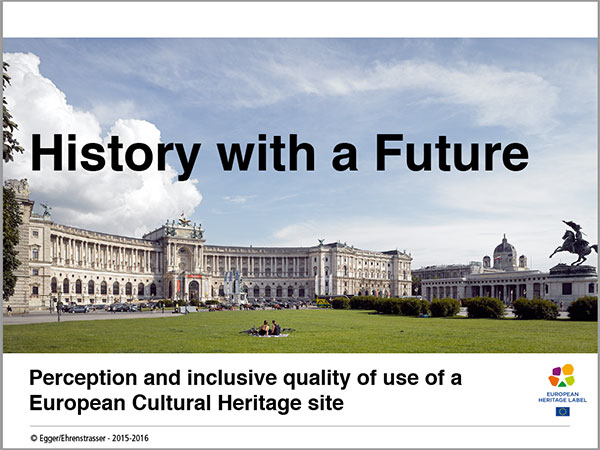History with a Future – Perception and inclusive quality of use of a European Cultural Heritage site
Presentation at the UD2016 conference in York, UK, 22-25 August 2016.
Authors: Veronika Egger and Lisa Ehrenstrasser
Key words: information spaces, design process, wayfinding, interaction, user experience

Abstract:
Imagine a 700 year old imperial palace that has grown from a medieval castle into an area in the middle of a city extending over half a million square meters (50 ha/123.5 ac). It houses the presidential quarters, various government offices, famous museums with strong identities in their own right, the national library and a congress centre. And it provides a focal point in the modern city for events that move the nation, some of them drawing over a hundred thousand people. We are in the central district of Vienna, Austria. To be more precise we are in the “Hofburg”, the imperial palace and seat of power of the Habsburg dynasty. It has been making history since 1275 and is still a living organism integrated into city life.
And this location – far too modest a term – is struggling with its identity. There is little or only a vague awareness among Viennese and tourists of the actual physical extent of this expanse of buildings, courtyards and parks. It doesn’t stand out as a palace, a castle, as the name would suggest. Over the years it has a grown into a complex structure difficult to understand and navigate. The site has been awarded the European Cultural Heritage Label in 2016, which carries the responsibility of communicating its value in an inclusive and accessible way to all visitors. This was our starting point.
In our first phase of discovery the complexity seemed to increase with every step. So we decided to pick up several strands of enquiry quite independent of each other. The idea was that we would be able to start connecting the dots as the data accumulated.
We focused on the most prominent locations within the Hofburg employing methods such as task analysis within scenarios of use in the real environment, mind maps, observation, interviewing various user groups and conducting moderated journeys. The issues that emerged during research included access options, pre-trip information about facilities, communication on site of what’s happening inside a building, the “feeling” and current use of a place with reference to its historic value as well as orientation and wayfinding.
Analysis of the data was challenging, but the dots did connect. We were able to identify three common dimensions in all methods used during the research process:
- emotion,
- perception,
- orientation.
By mapping the data for each location on these three dimensions we were able to visualize the key issues and present solid evidence regarding the quality of use in this historic space.
Design development is currently under way in four areas of implementation:
- Strategy for inclusive design at all levels (guidance for building and maintenance, delivery of online information, organization of access, enabling an experience of the space in cooperation with tour guides, etc.)
- Design of identity for the site.
- Design of an inclusive wayfinding and orientation system.
- Coordination with and inclusion of other initiatives and institutions on site.
At the time of the conference the Inclusive Design Strategy was at draft stage. It incorporates the use of surfaces and building features that enable a more diverse and multi-sensory user experience of the Hofburg Palace as well as the beginnings of a set of guidelines for the implementation of tactile features whenever construction work on the surfaces would be undertaken.
The presentation took the audience on a journey starting with the methods that were employed to understand the dynamics and challenges of this environment, demonstrating how user-centred research helped us formulate information and interaction design challenges leading towards the design of information spaces that work for all stakeholders and user groups.